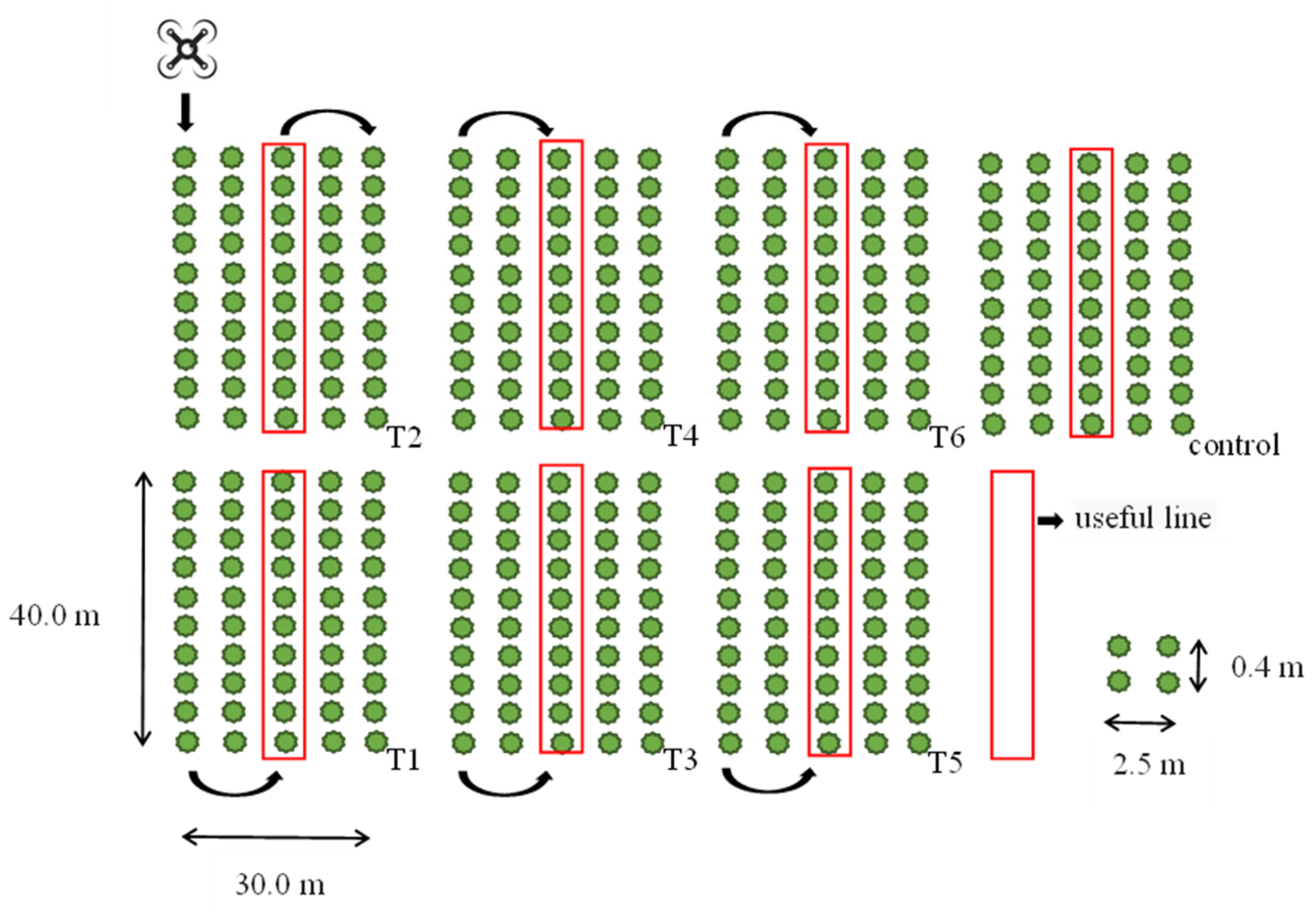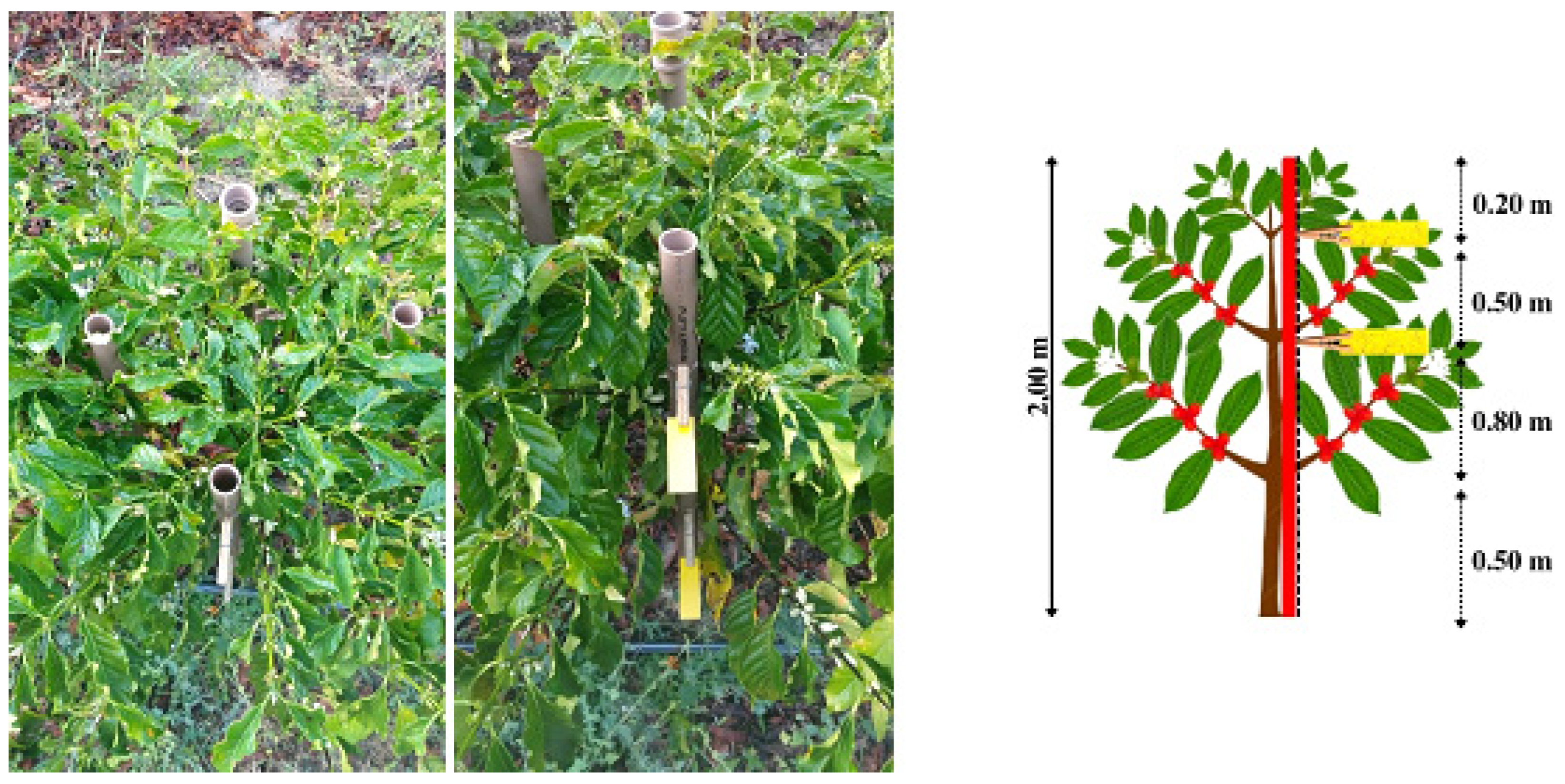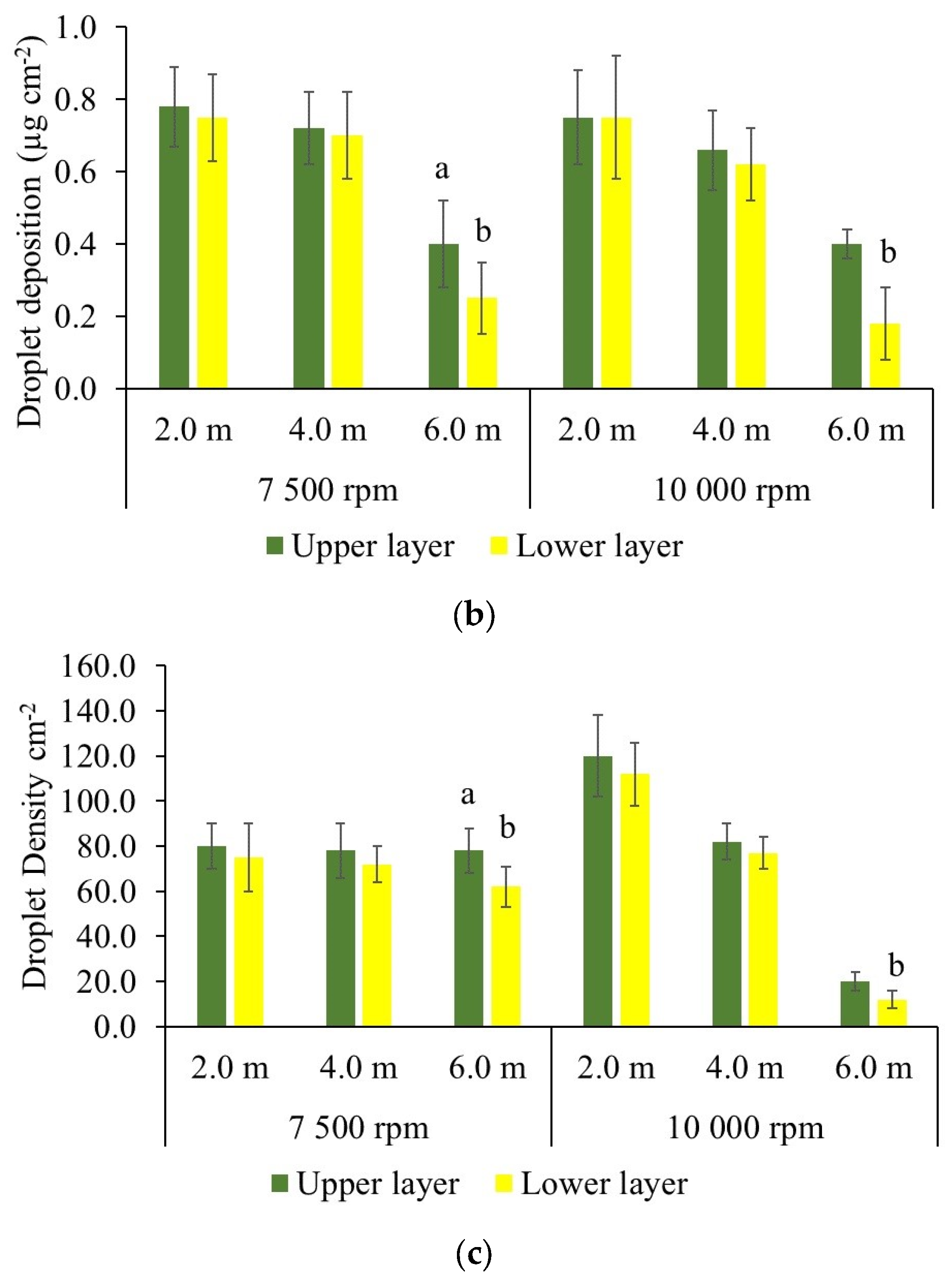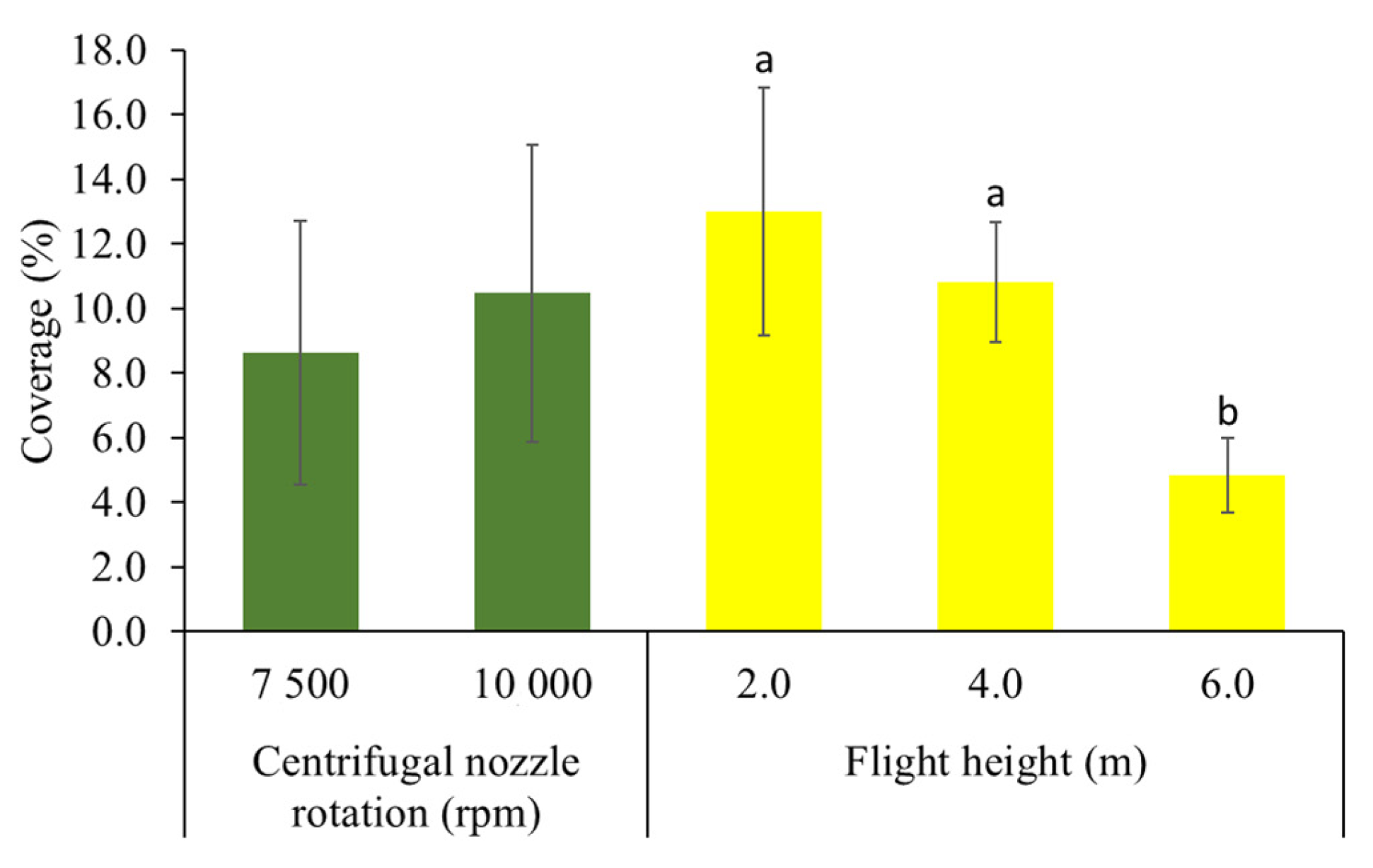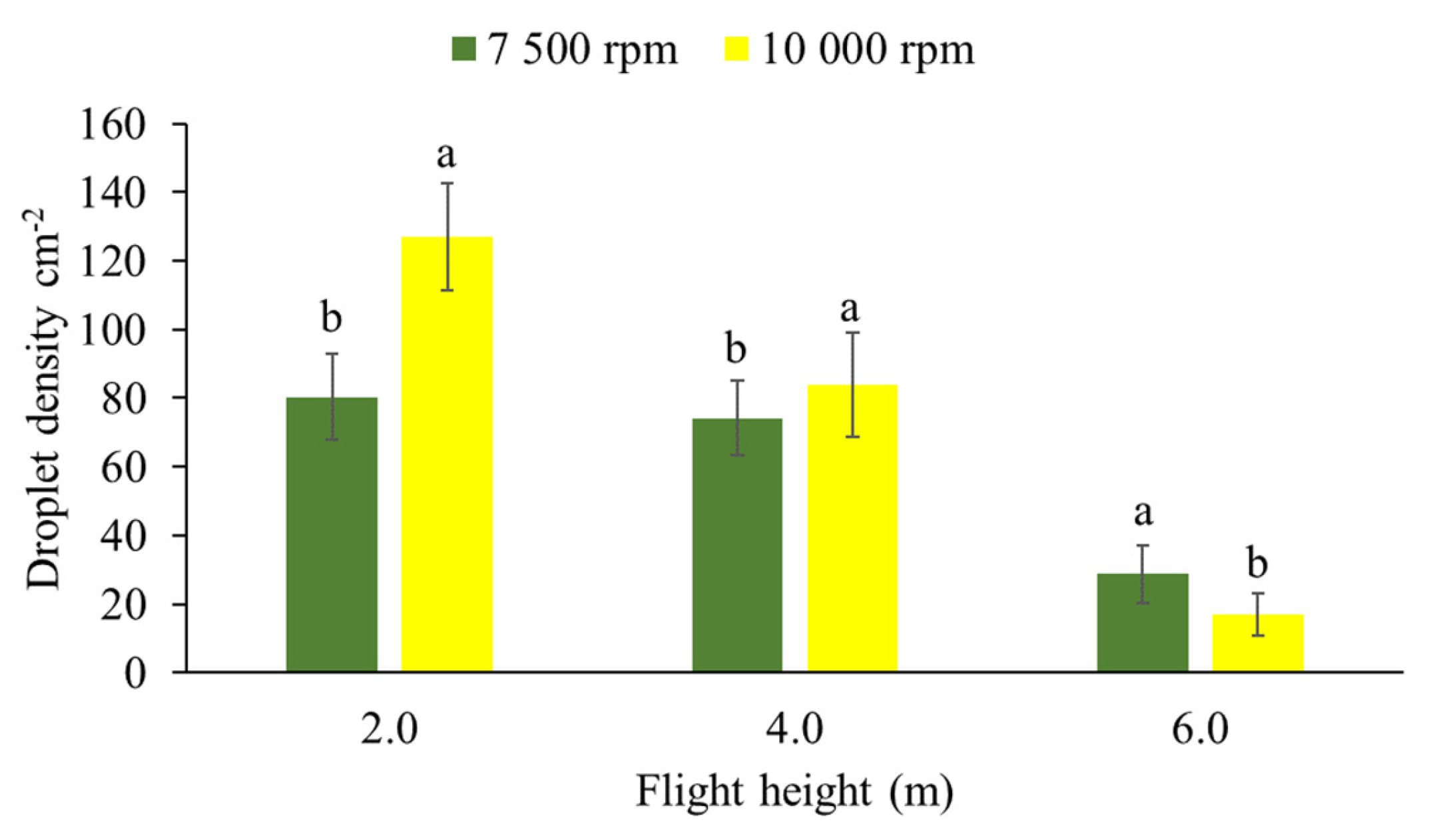1. Introduction
Coffee is one of the most traded commodities worldwide and one of the most consumed beverages in the world due to increases in consumption in emerging countries and interest in special coffees. The estimated world coffee production for the 2022–2023 crop season is 172.7 million bags (60 kg), approximately 80.1 million bags of Coffea canephora (Conilon + Robusta) and 92.6 million bags of Coffea arabica, with the highest increases in the European Union, United States, Japan, and Brazil [
1].
Coffee crops demand several adequate managements for ensuring economically viable yield levels, mainly mineral nutrition, which is one of the most expensive practices for this crop, since the plant cannot complete its cycle adequately without the use soil amendments and fertilizers. Thus, adequate availability and quantities of mineral macro- and micronutrients are required for supplying the demands of coffee plants and maintaining the nutritional balance [
2,
3,
4].
The methods that are commonly used for the application of agrochemicals and leaf fertilizers in coffee crops consist of growing applications with manual and electric backpack sprayers; and hydraulic, hydropneumatic, and pneumatic tractor sprayers. However, when these devices are used without the adequacy regarding the target to be reached, correct regulation and calibration can cause uneven application, slide of droplets, and spray drift and evaporation, resulting in negative impacts on the environment and health human; in addition, excess solution can affect slide, compromising leaf macronutrient absorption [
5]. Unmanned aerial vehicles (UAVs) are versatile due to their easy maneuverability and ultralow application rate, as well as the fact that they do not require specific area nor airstrips [
6]; have a low flight rate without load; and are adequate for applications in mountainous terrains, mud fields, and ground crops with high area leaf index. In addition, applications with UAV considerably decrease risks associated with agrochemical solutions and restrictions associated with several field conditions and reduce the work intensity and time [
7,
8].
Operational conditions for the UAVs used for the application of agrochemicals and their effects on the efficacy of the spraying and application were the focus of recent studies. These studies determined the effects of application rates, flow of spray tips, speed, operational height of flight, and planning flight pathways [
9,
10,
11]. However, these studies were specific, considering the application of agrochemicals, and investigations on the use of UAVs for the application of leaf fertilizers are scarce and limited to studies on application efficacy [
12], disregarding the efficacy of the adherence and absorption of the nutrients applied. Leaf fertilizers have characteristics connected to the solution mixture in the UAV application tank that affect the spraying efficacy and, consequently, the efficacy of retention of absorption of fertilizers, for example, the density, viscosity, and surface tension of the solution. In this sense, hydraulic spray nozzles and the application rate can compromise the application quality; the alternative for mixtures with pronounced physical characteristics is the application through centrifugal nozzles [
13,
14,
15,
16].
Thus, operational conditions for spraying using UAVs vary as a function of agricultural crops. Some experimental studies using UAVs as aerial sprayers were carried out for maize [
17], apple [
18], vine [
19], and citrus [
20] crops. All of them found significant effects of operational parameters during the applications. However, studies are focused on evaluating the application efficacy when used with tracer dyes and/or the efficacy of the control of pests and diseases using insecticides and fungicides, respectively, and studies on the application of leaf fertilizers are still scarce.
Whereas the studies on foliar fertilizer application by unmanned aerial vehicle are scarce or limited in regard to the aspects of droplet deposition efficiency and lack results that correlate the application efficiency with the efficacy of adherence and uptake of macroelements, the objective of the present work was to evaluate the effect of configurations of operational parameters of centrifugal nozzle rotation and operational height on the coverage, density, and deposition of droplets of the sprayed solution and evaluate the efficacy of retention and absorption of macronutrients applied by UAV in Conilon coffee plants.
3. Results
Figure 5 shows the comparative analysis of means of variables of efficacy between the upper and lower canopy layers within each height of flight and centrifugal nozzle rotation.
The coverage presents a higher means in the upper layer than in the lower layer, except in the height of flight of 6.0 m in the rotation of 10,000 rpm, i.e., 6.2% and 4.0%, respectively. The deposition and density of droplets presented significant differences in the height of 6.0 m in both rotations. In the rotation of 7500 rpm, the mean depositions were 0.401 and 0.231 µg cm−2 in the upper and lower layers, respectively, in the rotation of 10,000 rpm, the mean depositions were 0.397 and 0.188 µg cm−2 in the upper and lower canopy layers. The density of droplets presented similar results to the deposition: in the rotation of 7500 rpm, the density of droplets was 1.29-fold higher in the upper compared to the lower layer; in the rotation of 10,000 rpm, this value was 1.33-fold higher.
Considering the six combinations between operational height of flight and centrifugal nozzle rotation (three heights of flight and two centrifugal nozzle rotations), only one (6.0 m and 10,000 rpm) presented significantly different means between layers for the coverage and two (6.0 and 7500 rpm; 6.0 and 10,000 rpm) for the deposition and density of droplets. Thus, the criterion described in the statistical analysis was used; i.e., the variables of efficacy were analyzed as means of different points of collection in the two canopy layers.
Table 5 presents the synthesis of the analysis of data related to variables of efficacy of application of the sprayed solution using UAV. The asymmetry values varied from −0.26 to 0.2, and the kurtosis values varied from −1.95 to −1.63; these values denote that the three variables of efficacy present the normal distribution of the data collected in relation to their respective means. The normality of the data was confirmed by the Shapiro–Wilk test, with probabilities between 0.10 and 0.50; thus, the hypothesis of normality of errors was not rejected at the 5% significance level. The homogeneity of variances by the Bartlett test denoted that the variances of errors were homogeneous. The results of the normality of data, the independence of errors, and the homogeneity of variances are important assumptions for the analysis of variance (ANOVA). The coefficient of variance (CV) for each source of variation was between 12.2% and 33.4%; the CV in the ANOVA denotes the precision of the planning and obtaining of experimental data.
The centrifugal nozzle rotation did not affect the means of coverage of droplets and deposition of the spray solution (p-value = 0.088 and 0.603), as well as the interaction with the factor height of flight (p-value = 0.623 and 0.064); these variables were significantly affected in the contrasts of means only by the factor height of flight. The interaction between the centrifugal nozzle rotation and height of flight was significant in the contrasts of means for the density of droplets (p-value < 0.01 **).
The mean coverage of droplets at the height of flight of 2.0 m (12.4%) does not differ from that of the height of flight of 4.0 m (11.1%); however, it was three-fold higher than that of the height of flight of 6.0 (4.1%) (
Figure 6). Although the centrifugal nozzle rotation had no significant effect, the coverage in the rotation of 10,000 rpm (10.4%) is higher than that in the rotation of 7500 rpm (8.5%).
Figure 7 presents the means of deposition of sprayed solution. The centrifugal nozzle rotation did not significantly affect the deposition; the difference between the means was 0.020 µg cm
−2 (0.595–0.575 µg cm
−2). There was no significant difference in deposition means between the heights of flight of 2.0 (0.755 µg cm
−2) and 4.0 (0.642 µg cm
−2), but the deposition in the height of flight of 6.0 (0.358 µg cm
−2) was significantly higher, with a mean of deposition of 52.6%.
The means found for the density of droplets are shown in
Figure 8.
The density of droplets in the rotation of 10,000 rpm and at the height of flight 2.0 (127.1 droplets cm−2) was significantly higher than that in the rotation of 7500 rpm in the same height (80.4 droplets cm−2). The height of flight of 4.0 m presented significant difference (9.7 droplets cm−2) in the density of droplets, with 83.9 and 74.2 droplets cm−2 in the rotations of 10,000 and 7500 rpm, respectively. However, a significant difference in density of droplets between nozzle rotations was found for the height of 6.0 m, with an inversion in the mean values; i.e., the density in the rotation of 7500 rpm (28.7 droplets cm−2) was 1.7-fold higher than that in the rotation of 10,000 rpm (16.9 droplets cm−2).
The density of droplets in the centrifugal nozzle rotation of 7500 rpm was not affected by the heights of flight, presenting 80.4 droplets cm−2 at 2.0 m and 74.2 droplets cm−2 4.0 m. However, the density of droplets in the height of 6.0 m (28.7 droplets cm−2) was significantly different, with 51.7 droplets cm−2 and 45.5 droplets cm−2 in the heights of 2.0 and 4.0 m, respectively. In the centrifugal nozzle rotation of 10,000 rpm, the density of droplets was significantly different in the three heights of flight, with 127.1, 83.9, and 16.9 droplets cm−2 for the heights of 2.0, 4.0, and 6.0 m, respectively.
Table 6 presents the means of coefficients of variation (CVs) of variables of efficacy (coverage, density, and deposition of spray droplets). The normality and homogeneity of variance tests carried out for the data of CV for coverage, density, and deposition of spray droplets (W = 0.994, 0.884, and 0.759, respectively; χ
2 = 0.445, 0.449, and 0.477, respectively) allowed us to perform the analysis of variance. The mean CVs of coverage of droplets were affected by the centrifugal nozzle rotation (
p-value = 0.03 *) and height of flight (
p-value = 0.0055 **); the mean CV of the density of droplets was affected by the interaction between the factors (
p-value = 0.017 *), as well as the mean CV of the deposition of solution (
p-value = 0.017 *).
The CVs found denote the uniformity of distribution of droplets and depositions on water-sensitive paper tags (
Figure 9) and artificial targets. The uniformity of coverage was significantly lower at the height of 4.0 (52.7%) compared to those at the heights of 2.0 m (47.0%) and 6.0 m (44.7%). The uniformity of coverage analyzed within the centrifugal nozzle rotations showed better uniformity in the rotation of 7500 rpm (45.4%) in comparison to the rotation of 10,000 rpm (50.5%).
The uniformity of density of droplets was statistically equal in the rotations of 7500 and 10,000 rpm in the heights of flight of 2.0 m (45.2% and 44.2%, respectively) and 6.0 m (55.4% and 52.7%, respectively). At the height of flight of 4.0 m, the uniformity of density was significantly higher in the rotation of 7500 rpm (38.9%) compared to the rotation of 10,000 rpm (48.7%).
The mean CVs of uniformity of deposition of the sprayed solution were statistically equal in the centrifugal nozzle rotations of 7500 and 10,000 in the height of flight of 2.0 m (39.7% and 37.5%, respectively). In the heights of flight of 4.0 and 6.0 m, the uniformity was significantly different between rotations, with 28.4% in the rotation of 7500 rpm and 32.5% in the rotation of 10,000 rpm.
The analysis of data referring to macronutrient contents (N, P, and K) applied by the unmanned aerial vehicle are shown in
Table 7. Considering the asymmetry and kurtosis values of the data of macronutrient contents 15 days after application (DAA), they varied from −0.51 to 0.59 and from −0.98 to 1.38, respectively. Considering the Shapiro–Wilk (0.976 for N, 0.970 for P, and 0.985 for K) and Bartlett (11.87 for N, 11.82 for P, and 8.92 for K) test, the assumptions for the application of the test of variance were met. Similarly, macronutrient contents 30 DAA presented asymmetry varying from 0.02 to 0.48, kurtosis from −1.06 to −0.74, Shapiro–Wilk test results denoting normal distribution of the data, and the Bartlett homogeneity test denoting homogeneity of variances.
The ANOVA considered the six treatments formed by a combination of centrifugal nozzle rotations and heights of flight (
Table 2), i.e., 7500 rpm × 2.0 m (T1), 10,000 rpm × 2.0 (T2), 7500 rpm × 4.0 (T3), 10,000 rpm × 4.0 (T4), 7500 rpm × 6.0 m (T5), and 10,000 rpm × 6.0 m (T6), and a control treatment. The ANOVA showed significant differences (
p-value < 0.01 **) between the control treatment and each treatment for N, P, and K contents and a significant difference (
p-value < 0.01 **) between contrasts of combined means between treatments.
Figure 10 shows the results of the N, P, and K contents at 15 and 30 DAA.
The values mean N, P, and K contents in the control treatment at 15 and 30 DAA were 12.135, 0.786, and 8.219 g kg
−1 and 13.059, 0.987, and 8.110 g kg
−1, respectively. All treatments presented a significant difference in N contents, presenting increases from 18.4% (T5: 14.372 g kg
−1) to 41.7% (T1: 17.191 g kg
−1) at 15 DAA and from 14.0% (T6: 14.890 g kg
−1) to 42.5% (T1: 18.614 g kg
−1) at 30 DAA. The P contents increased from 16.5% (T6: 0.916 g kg
−1) to 70.0% (T3: 1.336 g kg
−1) at 15 DAA and from 8.9% (1.075 g kg
−1) to 34.4% (T1: 1.327 g kg
−1) at 30 DAA. The K contents increased from 8.7% (T5: 8.931 g kg
−1) to 54.3% (T1: 12.689 g kg
−1) at 15 DAA and from 13.9% (T6: 9.238 g kg
−1) to 60.6% (T1: 13.030 g kg
−1) at 30 DAA. The only treatment that presented no significant difference by increases in percentage in relation to the control treatment was the T5 for K contents at 15 DAA. The highest increase at 15 DAA was found for P contents (52.4%), and the highest increase at 30 DAA was found for K contents (39.6%;
Figure 9 and
Table 8).
The mean N, P, and K contents in the control treatment at 15 and 30 DAA were 12.135, 0.786, and 8.219 g kg−1 and 13.059, 0.987, and 8.110 g kg−1, respectively.
Figure 11 shows the results of macronutrient (N, P, and K) contents at 15 and 30 DAA in a boxplot. The boxplot was used as a graphical tool for a visual analysis of possible different distributions of macronutrient contents and values. In addition, it allowed a comparative graphical distribution.
N contents at 15 and 30 DAA show different dispersions among treatments, with the highest dispersion in T1, which showed the largest interquartile differences (ΔQ), 1.101 g kg
−1, and 2.5 g kg
−1. The lowest variabilities in N contents were found for T6 (ΔQ = 0.315 g kg
−1) and T4 (0.222 g kg
−1) at 15 DAA. T1 showed the highest average N content at 15 DAA (17.111 g kg
−1) and was significantly different from the other treatments. T2 (16.207 g kg
−1), T3 (16.512 g kg
−1), and T4 (16.706 g kg
−1) showed no difference among them. T1 showed 1.19 times higher N contents than T6 (14.321 g kg
−1; see
Figure 11a,b).
Figure 11c,d show the comparative graphs of P contents at 15 DAA and 30 DAA, respectively. The treatment with the greatest variability in P contents was T2, which showed Q1 equal 1.263 g kg
−1 and Q2 equal 1.385 g kg
−1, i.e., ΔQ equal 0.122 g kg
−1 at 15 DAA. The highest variability at 30 DAA was found for T1 (ΔQ = 0.093 g kg
−1). The lowest interquartile values were found for T6 at 15 DAA (ΔQ = 0.011 g kg
−1) and T3 at 30 DAA (ΔQ = 0.007 g kg
−1). T1, T2, T3, and T4 showed no significant difference in P contents at 15 DAA, showing 1.294, 1.314, 1.323, and 1.304 g kg
−1, respectively. T3 showed the highest average P content, being 31.4% higher than the treatment with the lowest average. The P contents at 30 DAA in T1 (1.308 g kg
−1) and T2 (1.341 g kg
−1) did not differ. T4, T5, and T6 showed the lowest mean P contents, 0.977, 1.082, and 1.040 g kg
−1.
The results of the mean K contents are shown in
Figure 11e,f. T2 showed variability in K contents at 15 and 30 DAA, with interquartile differences of 1.157 g kg
−1 at 15 DAA and 0.599 g kg
−1 at 30 DAA. T2 showed the highest mean K content (12.202 g kg
−1) at 15 DAA, and T1, T3, T4, and T5 showed no significant difference among themselves, with P contents of 9.500, 9.433, 10.005, and 8.904 g kg
−1. T3 showed the highest average K content at 30 DAA (13.113 g kg
−1), which is statistically superior to the other treatments. T1 (11.800 g kg
−1) and T5 (11.924 g kg
−1) formed a second group of K averages, and T6 (9.009 g kg
−1) showed the lowest average when compared to the others.
No discrepant value was found, regardless of the treatment and time (DAA); i.e., there was no value beyond the interval of interquartile detection.
4. Discussion
The result is justified because the effects of the heights of flight and centrifugal nozzle rotations on the distribution and deposition of droplets sprayed using the UAV on the canopy of Conilon coffee plants were evaluated in this study. The isolated factors and the interaction between the two factors had different impacts on the distribution and deposition of droplets. Considering the six possible combinations between the factors studied, with eighteen combinations between the height of flight and centrifugal nozzle rotations, for the three variables of application efficacy, only five presented significant differences between means. Thus, the mean values were considered for the coverage, density, and deposition of spray droplets in the two layers of the coffee plant canopy.
The coffee plants were pruned soon after annual harvest, and the leaf mass was reduced, facilitating the distribution and deposition of droplets in the two layers in which the data of efficacy were collected [
23].
The distribution and deposition of droplets in the coffee plant canopy were significantly affected by the operational heights of flight. The applications of droplets, which were sprayed close to the coffee plant canopy, had little or no effect from wind that could cause a significant drift; however, the chance that the sprayed droplets could be affected by height increased as the spraying height was increased [
11,
24,
25,
26].
The heights of flight of the UAV, combined with the centrifugal nozzle rotations, had different effects on the distribution of droplets. When analyzing the variables of application efficacy, the combination of the height of flight of 2.0 m and rotation of 10,000 rpm was that that resulted in the best coverage, density, and deposition of spray droplets; the density and deposition was significantly affected by the height of flight within the centrifugal nozzles rotations, and the density of droplets was significantly affected by the interaction between these two factors. These differences can be attributed to the architecture of the canopy of plants after the harvest pruning and distance between plants in the planting rows; plants closer to each other avoid the slide of the solution to the soil and contribute to a better penetration of the sprayed droplets. The effect of the centrifugal nozzle rotations on the deposition and uniformity of droplets was found in other studies [
13,
14,
15], as well as the effect of heights of flight [
12,
24,
25].
The uniformity of coverage, density, and deposition of spray droplets on the canopy of coffee plants varied significantly according to the heights of flight and centrifugal nozzle rotations. The mean coefficient of variation increased when the height of flight and rotation was increased to 10,000 rpm and decreased when the height of flight was decreased to 2.0 m. These differences in coefficients of variation can be due to the lack of obstacles between the nozzles and upper canopy layer. In addition to height of flight and centrifugal nozzle rotation, the downwash effect of the UAV generated by the UAV rotors and structure may have had a significant effect on the distribution and uniformity of droplets [
12,
14,
15].
Despite the different possible structural configurations of centrifugal nozzles according to the manufacturers, the droplet size and relative extension are usually similar [
16]. In most cases, the volume of solution applied by UAV is very low, which requires decreasing the size of droplets to optimize the coverage of the crop. In this sense, varying the centrifugal nozzle rotations may enable us to obtain different sizes of droplets [
14,
25]; and this explains the highest coverage, density, and deposition of spray droplets found in this study.
The mean macronutrient retention and absorption in the combined treatments (heights of flight and centrifugal nozzle rotations) increased compared to the control treatment. The treatments that resulted in the highest mean coverage, density, and deposition of spray droplets also presented the best means of absorption and retention of macronutrients (N, P, and K), namely the treatments T1 (2.0 m and 7500 rpm) and T2 (2.0 m and 10,000). These treatments were the most efficient and presented uniformity of distribution and deposition of droplets of the leaf fertilizers applied; therefore, the mode of spraying and application is an important factor for the efficacy of absorption of macronutrients.
Although the application efficacy is important, the retention and absorption of macronutrients should be analyzed holistically, considering other factors, such as those related to the plant’s age, leaf structure, and quantity of deposition on new leaves, as well as external factors, such as soil water availability, light availability, and climatic conditions [
15,
16,
17].
In addition to these factors, those related to the quality of spraying and application of leaf fertilizers should be considered, including the choice of fertilizers that have high dilution capacity in the mixture, and operational factors for the UAV calibration and adjusts, these factors were evident in treatments T1 and T2. Therefore, the height of flight and centrifugal nozzle rotations are important, but in addition to these factors, flight speed and the flow of the nozzles are important variables that define the quality of deposition and absorption of leaf fertilizers [
12].
In the comparative analysis between the treatments, the macronutrients N and P showed higher absorption and retention in T1 and T2. N has a characteristic of fast translocation in coffee leaves, and the quantity absorbed in the first 15 days after application (DAA) is high; moreover, it is improved by an efficient deposition of sprayed droplets. The P contents were similar in T1 and T2; however, the absorption increased at 30 DAA. The results of K absorption were higher in these treatments at 15 DAA. A high coverage and deposition of leaf fertilizers is essential to make the highest quantity of macronutrients available to be absorbed by coffee plants [
16,
17].

